LO4 Show commitment to and perseverance in CAS experiences Students demonstrate regular involvement and active engagement in CAS.
This past weekend, I was lucky enough to go to Weligama, with TAFA for a football coaching camp. I happily left my house on Friday afternoon, and I was lucky to have Aaron (another TAFA Intern), drive me there, along with the other Interns (Emily, Ruben and Banda). We got there in the afternoon, and we checked into the hostel we were staying at, called Hangtime, and met up with Sam (who got there with the other coaches). That night, after a fun afternoon of surfing the Weligama waves, we prepared for the Coaching Camp the next day (on Saturday). We all drove to Galle to pick up some water bottles, Pepsi Bottles, and Sting Energy drinks, as a TAFA sponsorship to give out to the other teams the next day. After the drive back, we stopped for some Kottu and packed our bags for the next day for the coaching camp.
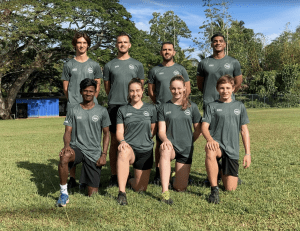
Saturday morning was a very early one, as we had to get there in time to prepare the field and drills for all the teams coming over. I was told that there was going to be around 50 local Weligama players coming to play football with us. They would have a training session for around 1 hour, and then one of the local teams was going to play the TAFA “Select” Under 14 Boys team, as a friendly match at the end. To begin to prepare, we had to start unpacking all of the materials and coaching equipment from the van and trucks. Since we were giving away TAFA hats, as a “gift” to the opposing team, I had the job of counting the caps to see if we had enough, and Emily was counting the different sizes of the TAFA kits. Next, for some publicity and advertisement, all of us Interns had to take photos in front of the field, and then we had a whole coaching staff photo as well.
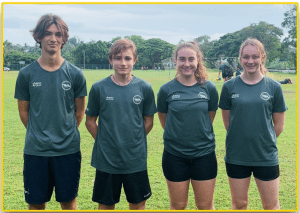
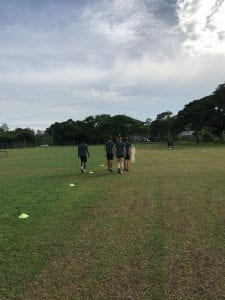
After we got set up for the gifts and the basic setup, we all had to begin setting up the field with different drills and setting up the nets ready for the final game. The night before, Coach Eddie explained to us that we were going to do a rotation of 4 different drills for each of the players, and every 2 coaches would run a drill. We all began laying out cones for the 4 different drills (A fitness section, a dribbling around cones section, a basic skills section, and a mini-match section). We put out the corner rhino poles, the cones for separating, and all the mini-goals, bibs, hurdles, cones and other equipment on each of the 4 stations. Then, we faced the challenge of putting the big nets onto the massive goal posts. Usually, there are little hooks on the goalposts, which are very useful to hook the net on quickly. However, these nets were completely smooth, with no way of attaching the nets on.
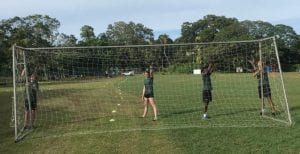
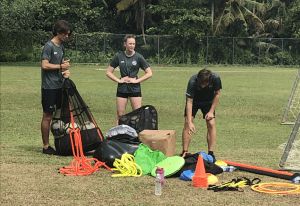
Additionally, they were so massive, I found it difficult to keep the nets on without them sliding back off. After a few minutes of pondering what to do in this situation, we came up with a great solution to this problem. One of us spotted some little pieces of the broken-off net on the floor, (which was all twisted together to make a string) and we collectively used the minuscule pieces of string to tie on the net to the goal post, on the bottom, top and sides of it, in order to secure it for the match later that day.
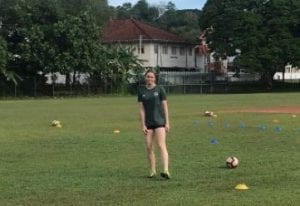
Although this doesn’t really seem like a big achievement to outsiders, this was a really proud achievement of mine (and assumably the other interns), as we came up with an innovative solution to use instead of the Zipties that we forgot to bring. (which we usually use to put the nets on).
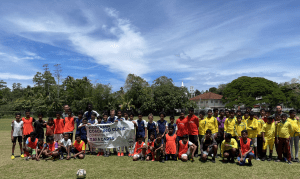

Next, we anxiously waited for the team’s arrival. In a quick coaches team meeting, Eddie (the head coach), explained to us how the day was going to look. He mentioned that Sam and Emily will be in charge of the Fitness/Agility Drill, Henry will be in charge of the football handling skills drill, Ruben and Banda will be in charge of the miniature game drill, and Aaron and I will be in charge of the Cone dribbling drills. Then, once Eddie finished explaining the two other schools had arrived. There were around 25 players in each school, and in total, we were coaching around 12 players at each station individually. Quickly, Eddie briefed the local footballers about each of the stations, and shortly, he sent a group of players to each station. For each drill, we spent around 12 minutes coaching them and allowing them to perform the drill, with a 3-minute rest in between each drill.


Next, we began the coaching part of the camp. As we went through the 4 different groups, coach Aaron first introduced himself, and me in either Singhala or Tamil (according to what most of the players in each group spoke), and continued to explain each of the drills. We had a miniature zig-zag dribbling drill, a straight line dribbling drill, a toe-tap dribbling drill (where the players had to go forwards, then backwards than forwards), we had a weaving dribbling drill and a larger zig-zag drill. As soon as Aaron blew the first whistle to start the players on their drill, I knew immediately that I would need to help them to complete the drills. Most of them seemed tentative to get going, and they required lots of prompting and encouragement to get going. However, once they got going it was much better.
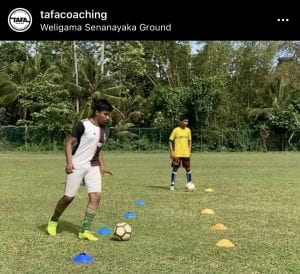
There were two main areas I needed to help with with the first group of players. Since it was all new for them, I needed to help explain to them how to do the drill itself while they started up, and after that, I needed to help them improve their skills and techniques, by introducing coaching points such as keeping their heads up (not looking at their feet), telling them which part of their feet to use (inside, outside, etc), and introducing changes in pace. This was a very tricky balance to make, as each player has a different skill level, and the main goal was to get the players to play football. So, if a specific player had more basic football skills, I wanted to make sure they maximize their playing time, rather than spending ages trying to get them to do each part of the drill “correctly”. This is because since a few players had limited experiences with a football at their feet, I wanted to give them as much time as possible to have practice with a ball.
LO2 Demonstrate that challenges have been undertaken, developing new skills in the process A new challenge may be an unfamiliar experience or an extension of an existing one. The newly acquired or developed skills may be shown through experiences that the student has not previously undertaken or through increased expertise in an established area.
With regards to coaching, the first major challenge I faced was having to overcome the language barrier between me and the players I was coaching. I speak primarily English (with a spotty knowledge of French), and despite my 10 years living in Sri Lanka, my Sinhala and Tamil knowledge is significantly limited. Besides some basic greetings, phrases and directions, I hardly knew any Singhala words. This was a challenge because all the players I was coaching spoke either (and only) Singhala and Tamil, with limited English knowledge. Thankfully, Aaron could speak both, so he did the majority of the explaining the drills, at the beginning of each session. My lack of language skills originally made me feel very useless in coaching, as I was limited to how much I could help the players learn. However, when I spotted some players in our group doing a drill wrong, I used my basic directional skills (combined with their basic English colour knowledge), to properly explain how to do the drill for them. I explained that first (1), the toe tap (which I demonstrated), straight, “kelinma”, then backwards “piṭupasa”. These (very) basic directional words helped me better overcome my communication challenge with the players. Another way that I overcame this challenge was by using my non-verbal communication skills
LO1 Identify own strengths and develop areas for growth Students are able to see themselves as individuals with various abilities and skills, of which some are more developed than others.
I had quite a few strengths as a coach, and I think I helped many of the players by giving them advise on how to do better, explaining the drills to them in detail, and helping them to spend as much time at hey could playing football! And, trying to get them to take as many touches on the ball as possible
I also had loads of areas for growth, and different ways I could improve my coaching skills to better convey what I was trying to teach them and to be more understanding. Here are some ways I could improve:
- Standing position – standing opposite to my co-coach in a way that I could either see the whole drill, or close up, in a 1-1 scenario
- Being more confident in my demonstration of drills, and my abilities
- Being more confident to be straightforward when communicating with the players, being okay with trying to speak sinhala words
- Finding the balance between getting them to do the drill properly, as was intended, or just letting the players get as much time with the balls at their feet as possible, and balancing these two things out
LO6 Demonstrate engagement with issues of global significance Students are able to identify and demonstrate their understanding of global issues, make responsible decisions, and take appropriate action in response to the issue either locally, nationally or internationally.
This helped interact with the global issue of poverty, and lack of sporting opportunities for many people. These young boys were all so enthusiastic to be playing football, and they just wanted to get better and better. During one moment of the training session, Aaron had said to the players “you should try to do this everyday, just grab a ball, and practice this drill”. Then, in a heart-breaking moment, one of the little boys replied “Sir, we cannot afford a football”. This was so upsetting to me, and I found the inequality between the kids I usually coach and these viallge kids so devastating, as everyone deserves equal opportunities in life, and this is sadly not the case. So, I felt really happy on this day, to be giving some young footballers an opportunity to play football. I tried to get them to have as much fun as they could, and I taught them each a couple of things about football. We also helped them by giving away football supplies for them to keep after the game, so they could keep practicing! We gave away footballs, cones, TAFA hats, and even sports shirts. This made me so happy to know that these players would be able to keep developing their skills. In a very humbling match after the training session, the TAFA Select Boys Team played against one of the village school teams, and the Village school won! This was incredibly humbling as they had a 1 hour training session before the match, and they also had extremely less opportunities to practice and train in football, than these boys who trained more than 6 hours per week. This was a really humbling game, and the win by the village team was extremely well-deserved.
Learning Outcomes:
LO1 Identify own strengths and develop areas for growth Students are able to see themselves as individuals with various abilities and skills, of which some are more developed than others.
LO2 Demonstrate that challenges have been undertaken, developing new skills in the process A new challenge may be an unfamiliar experience or an extension of an existing one. The newly acquired or developed skills may be shown through experiences that the student has not previously undertaken or through increased expertise in an established area.
LO4 Show commitment to and perseverance in CAS experiences Students demonstrate regular involvement and active engagement in CAS.
LO6 Demonstrate engagement with issues of global significance Students are able to identify and demonstrate their understanding of global issues, make responsible decisions, and take appropriate action in response to the issue either locally, nationally or internationally.
By: Chloe Grandbois
These are epic, well-documented posts Chloe! Thanks for taking the time to document your learning and growth as a coach in TAFA. We look forward to it returning to face-to-face sessions.
Mr. Lockwood
[email protected]